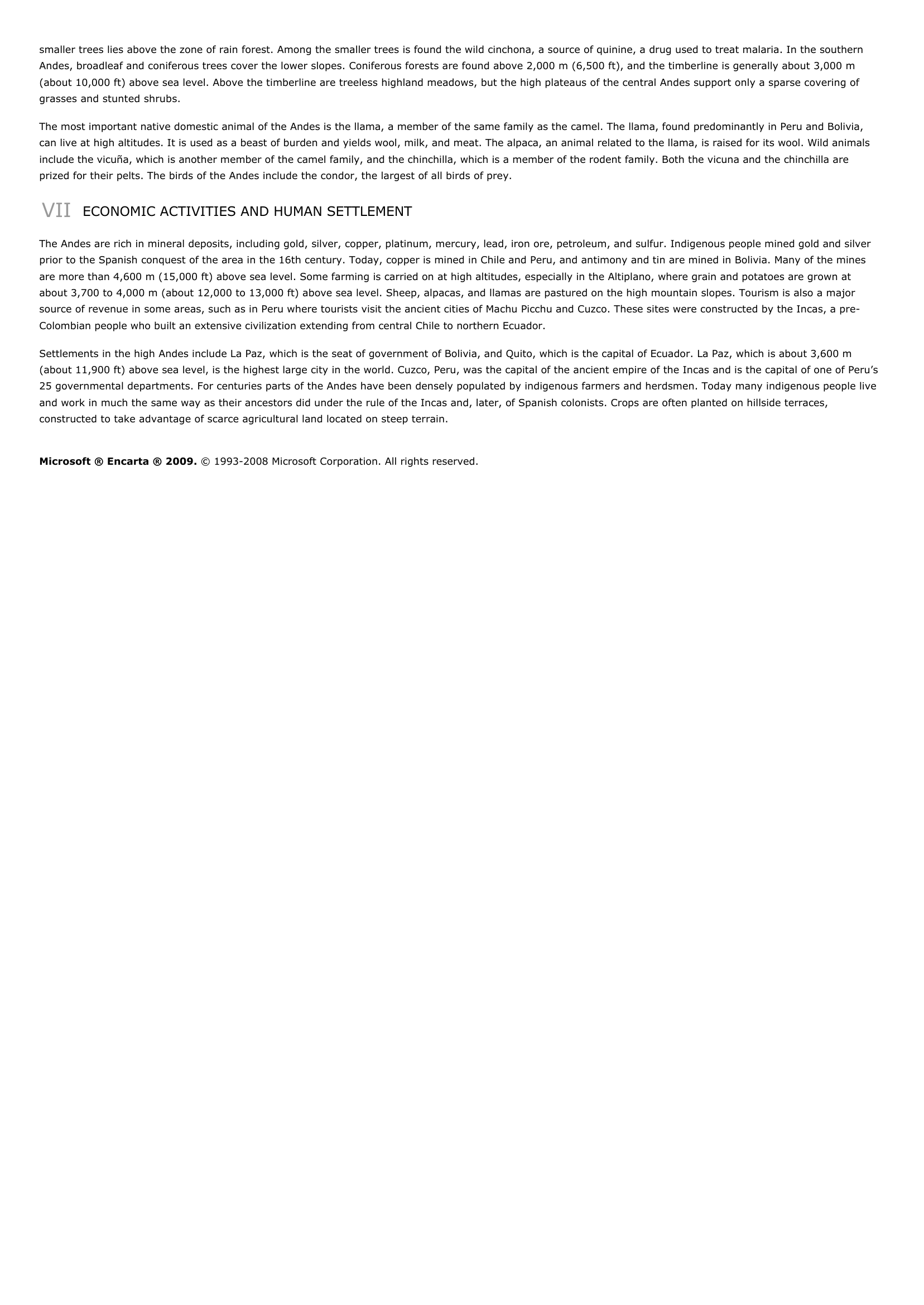Andes - geography.
Publié le 04/05/2013

Extrait du document
«
smaller trees lies above the zone of rain forest.
Among the smaller trees is found the wild cinchona, a source of quinine, a drug used to treat malaria.
In the southernAndes, broadleaf and coniferous trees cover the lower slopes.
Coniferous forests are found above 2,000 m (6,500 ft), and the timberline is generally about 3,000 m(about 10,000 ft) above sea level.
Above the timberline are treeless highland meadows, but the high plateaus of the central Andes support only a sparse covering ofgrasses and stunted shrubs.
The most important native domestic animal of the Andes is the llama, a member of the same family as the camel.
The llama, found predominantly in Peru and Bolivia,can live at high altitudes.
It is used as a beast of burden and yields wool, milk, and meat.
The alpaca, an animal related to the llama, is raised for its wool.
Wild animalsinclude the vicuña, which is another member of the camel family, and the chinchilla, which is a member of the rodent family.
Both the vicuna and the chinchilla areprized for their pelts.
The birds of the Andes include the condor, the largest of all birds of prey.
VII ECONOMIC ACTIVITIES AND HUMAN SETTLEMENT
The Andes are rich in mineral deposits, including gold, silver, copper, platinum, mercury, lead, iron ore, petroleum, and sulfur.
Indigenous people mined gold and silverprior to the Spanish conquest of the area in the 16th century.
Today, copper is mined in Chile and Peru, and antimony and tin are mined in Bolivia.
Many of the minesare more than 4,600 m (15,000 ft) above sea level.
Some farming is carried on at high altitudes, especially in the Altiplano, where grain and potatoes are grown atabout 3,700 to 4,000 m (about 12,000 to 13,000 ft) above sea level.
Sheep, alpacas, and llamas are pastured on the high mountain slopes.
Tourism is also a majorsource of revenue in some areas, such as in Peru where tourists visit the ancient cities of Machu Picchu and Cuzco.
These sites were constructed by the Incas, a pre-Colombian people who built an extensive civilization extending from central Chile to northern Ecuador.
Settlements in the high Andes include La Paz, which is the seat of government of Bolivia, and Quito, which is the capital of Ecuador.
La Paz, which is about 3,600 m(about 11,900 ft) above sea level, is the highest large city in the world.
Cuzco, Peru, was the capital of the ancient empire of the Incas and is the capital of one of Peru’s25 governmental departments.
For centuries parts of the Andes have been densely populated by indigenous farmers and herdsmen.
Today many indigenous people liveand work in much the same way as their ancestors did under the rule of the Incas and, later, of Spanish colonists.
Crops are often planted on hillside terraces,constructed to take advantage of scarce agricultural land located on steep terrain.
Microsoft ® Encarta ® 2009. © 1993-2008 Microsoft Corporation.
All rights reserved..
»
↓↓↓ APERÇU DU DOCUMENT ↓↓↓
Liens utiles
- Andes - geography.
- CONDOR DES ANDES
- Ejército de los Andes - historia.
- Principales cumbres de los Andes CUMBRE PAÍS ALTITUD Aconcagua Argentina 6.
- Mendoza, ville d'Argentine, dans les Andes, chef-lieu de la province du même nom et métropole régionale du Cuyo.










